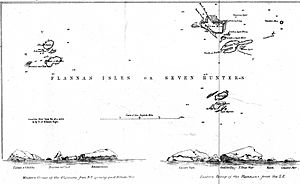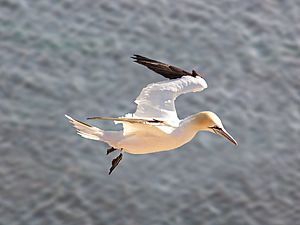Flannan Isles facts for kids
| Gaelic name | Na h-Eileanan Flannach |
|---|---|
| Meaning of name | Flannan Isles |
| OS grid reference | NA720460 |
| Coordinates | 58°18′N 7°36′W / 58.3°N 7.6°W |
| Physical geography | |
| Island group | Lewis and Harris |
| Area | 58.87 ha (145.5 acres) over more than seven islands. |
| Area rank | Eilean Mòr is 325th |
| Highest elevation | 88 m (289 ft), on Eilean Mòr |
| Administration | |
| Sovereign state | United Kingdom |
| Country | Scotland |
| Council area | Na h-Eileanan Siar |
| Demographics | |
| Population | 0 |
| Largest settlement | Flannan Isles Lighthouse is the only habitable structure |
The Flannan Isles (Scottish Gaelic: Na h-Eileanan Flannach), also known as the Seven Hunters, are a small group of islands. They are part of the Outer Hebrides in Scotland. These islands are about 32 kilometers (20 miles) west of the Isle of Lewis. They might be named after Saint Flannan, an Irish preacher from the 7th century. No one has lived on the islands permanently since the Flannan Isles Lighthouse became automatic in 1971.
Contents
Exploring the Flannan Isles: Geography and Landscape
The Flannan Isles are made up of several smaller islands and rocks. They are divided into three main groups.
Northeastern Islands: Eilean Mòr and Eilean Taighe
The main group of islands is in the northeast. This includes the two biggest islands:
- Eilean Mòr, which means "Big Isle." It covers about 17.5 hectares (43 acres).
- Eilean Taighe, which means "House Isle."
To the south, you'll find Soray (Eastward Isle) and Sgeir Tomain. The main islands in the west are Eilean a' Ghobha (Isle of the Blacksmith), Roaireim (which has a natural rock arch), and Bròna Cleit (Sad Sunk Rock).
The total land area of all the islands is about 50 hectares (124 acres). The highest point is on Eilean Mòr, reaching 88 meters (289 feet) above sea level.
Island Geology and Ancient Ice
The islands are made of dark rocks like gabbros and dolerites. These rocks push through older rock called gneiss. Long ago, huge sheets of ice covered this area. These ice sheets spread from Scotland into the Atlantic Ocean.
About 20,000 years ago, after the ice melted, sea levels were much lower. It is likely that the Flannan Isles were once part of a much larger landmass. Even then, they were still separated from the main Outer Hebrides by many miles of water. Over time, sea levels rose steadily. This reduced the land above water to what we see today.
Visiting Eilean Mòr
There are two possible places for boats to land on Eilean Mòr. These are on the east and west sides. However, landing can be dangerous because the sea often has strong waves.
History of the Flannan Isles
The name Eilean Taighe means "House Isle." This is because it has the remains of an old stone shelter. On Eilean Mòr, you can find the lighthouse and the ruins of a small chapel. This chapel was dedicated to Saint Flannán. Lighthouse keepers used to call it the "dog kennel" because it was so tiny. These ruined shelters were known as the Bothies of the Clan McPhail.
Who was Saint Flannán?
It's not completely clear which Saint Flannán the chapel honors. It might be a 7th-century abbot from Killaloe, Ireland. Or it could be the half-brother of St Ronan, who lived in the 8th century. Saint Ronan gave his name to the nearby island of North Rona. There was also a man named Flann, who was the son of an abbot from Iona. He died in 890 and might also be the saint the islands are named after.
Other Names and Old Customs
The Flannan Isles are also known as The Seven Hunters. During the Middle Ages, they might have been called the Seven Haley (Holy) Isles. In 1703, a writer named Martin Martin wrote about some unusual customs. People used to make regular trips to Eilean Mòr. When they reached the top, they would take off their hats and turn in a sunwise direction.
Wildlife of the Flannan Isles
The Flannan Isles are an important home for many seabirds. These birds come here to build their nests.
Birdlife and Other Animals
Some of the seabirds found here include:
- Atlantic puffins
- Northern fulmars
- European storm-petrels
- Leach's petrels
- Common shag
- Black-legged kittiwakes
There is also a large group of gannets on the island of Roaireim. For many centuries, people from Lewis would visit these nests. They collected eggs, birds, and feathers.
The islands also have a population of rabbits. Lighthouse keepers brought these rabbits to the islands. Farmers from Bernera also let their sheep graze on the most fertile islands.
Marine Life Around the Islands
In the waters around the Flannan Isles, you can often see different types of whales and dolphins. These include:
- Minke whales
- Pilot whales
- Risso's dolphins
- Other species of dolphin
The islands became a Site of Special Scientific Interest in December 1983. This means they are protected because of their special wildlife.
The Mystery of the Lighthouse Keepers
The Flannan Isles are famous for a strange event that happened in December 1900. All three lighthouse keepers disappeared in a mysterious way. An official investigation looked into what happened. They decided that the three men were probably swept away by rough weather. This happened while they were working near the edge of a cliff.
The Flannan Isles in Stories
The Flannan Isles have inspired many stories and films.
Books and Novels
- The islands are the main setting in a short story called On the Isle of Blue Men. This story was written by Robert W. Sneddons in 1927. It's a thrilling story with a mysterious, scary feel.
- Neil Gunn's novel The Silver Darlings, published in 1941, describes a visit to the islands.
- Eilean Mòr is also important in the 2016 novel Coffin Road by Peter May. A murder happens there, which is central to the story.
Films Inspired by the Mystery
- The 2019 film The Vanishing is set on the Flannan Isles. It stars Gerard Butler and Peter Mullan. The film was inspired by the famous disappearance of the lighthouse keepers.
See also
In Spanish: Islas Flannan para niños



